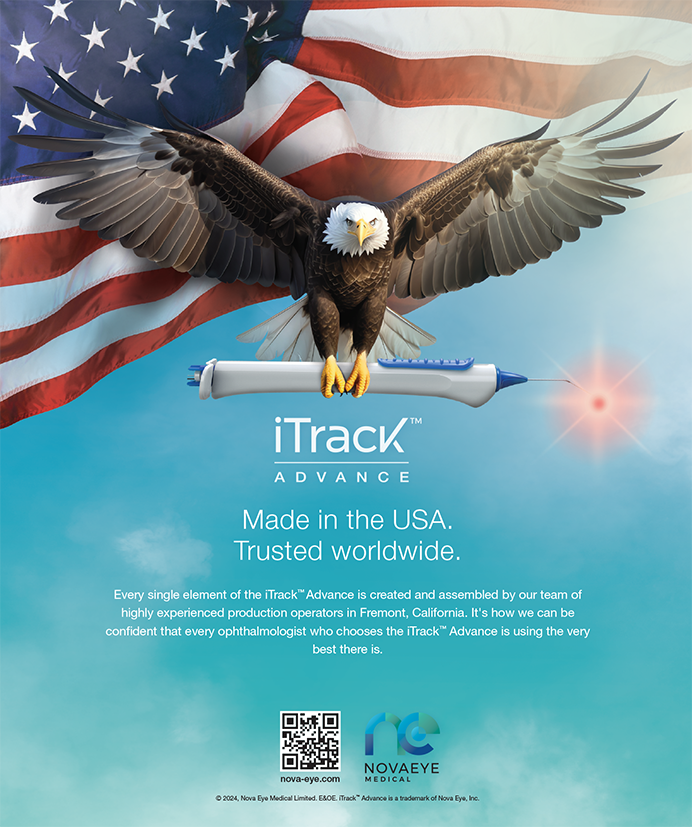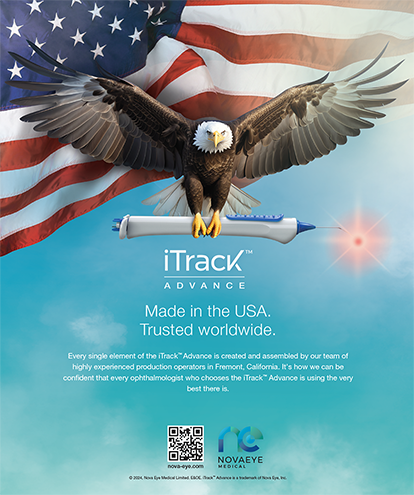
Teleophthalmology has emerged as a useful tool during the COVID-19 pandemic to provide remote eye care to patients at home. Virtual visits may include history taking and a limited anterior segment examination, whereas other components of the standard glaucoma evaluation—such as IOP measurement and perimetry—may be more challenging to incorporate. This article reviews existing and evolving technologies for home-based glaucoma monitoring.
AT A GLANCE
- Home-based glaucoma monitoring has the potential to increase patients’ involvement in their glaucoma care and to optimize adherence.
- Areas for future research include the development of at-home imaging of the angle and OCT of the retinal nerve fiber layer and additional validation of portable visual field testing programs.
- If proven to be economical, easy to use, and widely accepted by physicians and patients, virtual technologies may revolutionize the delivery of glaucoma care.
HOME-BASED TONOMETRY
Home-based tonometry holds promise for uncovering IOP spikes and fluctuations that might otherwise be missed during office visits. The Icare Home (Icare) is an FDA-approved portable rebound tonometer that is designed for use by patients at home. The Icare Home does not require the use of a topical anesthetic, and it masks the patient to the IOP readings, which can later be downloaded and reviewed by the ophthalmologist. In a study of 130 patients with a diagnosis of glaucoma or glaucoma suspect, Takagi and colleagues1 found good agreement between IOP measurements obtained by patients and ophthalmologists using the Icare Home. Of note, the Icare Home overestimated IOP when compared with Goldmann applanation tonometry, and the degree of overestimation was greater with increasing central corneal thickness.1
The Icare Home has been used successfully to monitor both pediatric and adult patients at home, including in the postoperative period. In one study of seven children with measurements taken by parents, the device identified reductions in mean IOP and mean daily IOP fluctuations after interventions to enhance aqueous outflow, and it demonstrated a greater than 90% likelihood of detecting an IOP spike over a 2-week period.2 In a series of 19 children who underwent placement of Baerveldt glaucoma implants (Johnson & Johnson Vision), the Icare Home tonometer detected 12 of 13 (92.3%) spontaneous tube openings.3 The Icare Home has also been used to provide home monitoring of IOP after selective laser trabeculoplasty in adult patients, with no reported safety issues.4 However, studies have found varying degrees of feasibility, as the device may be too cumbersome for some patients to use.5,6 An additional limitation is its cost.
The FDA-approved Triggerfish contact lens sensor (Sensimed) provides 24-hour noninvasive monitoring of circumferential changes at the corneoscleral junction, measured in millivolt equivalents, as a surrogate for IOP. Data are wirelessly transmitted to a portable unit worn on the patient’s waist. Mansouri and colleagues7 found fair to good reproducibility in a study of 40 patients with a diagnosis of glaucoma or glaucoma suspect who wore the contact lens sensor during two separate 24-hour sessions. Adverse events included transient conjunctival hyperemia and blurred vision, with most patients reporting acceptable tolerability.7 One study using the contact lens sensor reported larger fluctuations in ocular dimensions over a 24-hour period in patients with normal-tension glaucoma versus controls.8 Further research is needed to better elucidate the relationship between millivolt equivalents and IOP.
HOME-BASED PERIMETRY
Several portable alternatives to standard automated perimetry have been developed for glaucoma screening in rural and underserved populations. Some of these technologies may be amenable to use at home. Melbourne Rapid Fields (MRF; formerly known as Visual Fields Easy; Glance Optical) is a free tablet-based application that tests up to 30° of visual field (VF) horizontally and 24° vertically. MRF has shown good correlation to Humphrey Field Analyzer (HFA; Carl Zeiss Meditec) 24-2 Swedish Interactive Thresholding Algorithm (SITA) for test-retest reliability and mean deviation and pattern standard deviation indices.9,10 A screening study of 206 patients in Nepal found that MRF effectively identified moderate and advanced visual defects but was less reliable in detecting early loss.11
Peristat online perimetry is a free web-based VF program that tests 24° of horizontal field and 20° of vertical field on a 17-inch or larger computer monitor. The number of abnormal (missed) points using Peristat correlated well with those missed on HFA 24-2 SITA Standard VFs.12 However, if used as a one-time screening test, Peristat may miss up to 46% of mild glaucoma and at least 14% of moderate to severe glaucoma.12
Virtual reality–based VF testing using head-mounted displays is also in development. The MVP FDT (frequency doubling technology) app uses a smartphone and a head-mounted display to perform mobile virtual perimetry and has demonstrated good correlation to the Humphrey FDT (Carl Zeiss Meditec).13 The C3 Field Analyzer (Alfaleus and Remidio) is another head-mounted virtual reality test that has demonstrated moderate reliability; however, the device showed poor correlation to HFA mean deviation and pattern standard deviation indices in a study of 157 patients who were treated at Aravind Eye Hospital.14
The feasibility, efficacy, and reliability of these novel VF modalities require further study before they can be routinely used to diagnose and monitor glaucoma at home. In its current state, portable perimetry remains limited in its ability to identify early disease and monitor patients for progression and is likely best reserved as a screening tool.
HOME-BASED OPTIC DISC IMAGING
Smartphone-based optic disc imaging may have potential as a teleglaucoma tool. Pujari and colleagues15 obtained optic disc photographs using an iPhone XS Max (Apple) after pharmacologic dilation of five patients. Images were compared with standard stereoscopic disc photographs by a masked reader. Although the smartphone-based disc photographs enabled identification of glaucomatous features (eg, increased cup-to-disc ratio), the standard photographs were deemed to be of better quality.15
In a study by Wintergerst et al, undilated and dilated optic disc images obtained from 54 eyes using a Samsung Galaxy S4 (Samsung) and the D-Eye adapter (D-Eye) were compared with standard disc photographs by two masked readers. Pupillary dilation enhanced smartphone image acquisition and quality. Estimated vertical cup-to-disc ratio correlated well between standard disc photographs and dilated smartphone-based images and was underestimated by undilated smartphone-based images.16 The need for an assistant capable of reliably capturing images of sufficient clarity may limit the utility of smartphone-based optic disc imaging at home.
CONCLUSION
Home-based glaucoma monitoring has the potential to increase patients’ involvement in their glaucoma care and to optimize adherence. Areas for future research include the development of at-home imaging of the angle and OCT of the retinal nerve fiber layer and additional validation of portable VF testing programs. If proven to be economical, easy to use, and widely accepted by physicians and patients, such technologies may revolutionize the delivery of glaucoma care.
1. Takagi D, Sawada A, Yamamoto T. Evaluation of a new rebound self-tonometer, Icare Home: comparison with Goldmann applanation tonometer. J Glaucoma. 2017;26(7):613-618.
2. Bitner DP, Freedman SF. Long-term home monitoring of intraocular pressure in pediatric glaucoma. J AAPOS. 2016;20(6):515-518.
3. Go MS, Barman NR, House RJ, Freedman SF. Home tonometry assists glaucoma drainage device management in childhood glaucoma. J Glaucoma. 2019;28(9):818-822.
4. Awadalla MS, Qassim A, Hassall M, Nguyen TT, Landers J, Craig JE. Using Icare Home tonometry for follow-up of patients with open-angle glaucoma before and after selective laser trabeculoplasty. Clin Exp Ophthalmol. 2020;48(3):328-333.
5. Cvenkel B, Velkovska MA, Jordanova VD. Self-measurement with Icare HOME tonometer, patients’ feasibility and acceptability. Eur J Ophthalmol. 2020;30(2):258-263.
6. Mudie LI, LaBarre S, Varadaraj V, et al. The Icare Home (TA022) Study: performance of an intraocular pressure measuring device for self-tonometry by glaucoma patients. Ophthalmology. 2016;123(8):1675-1684.
7. Mansouri K, Medeiros FA, Tafreshi A, Weinreb RN. Continuous 24-hour monitoring of intraocular pressure patterns with a contact lens sensor: safety, tolerability, and reproducibility in patients with glaucoma. Arch Ophthalmol. 2012;130(12):1534-1539.
8. Kim YW, Kim JS, Lee SY, et al. Twenty-four–hour intraocular pressure–related patterns from contact lens sensors in normal-tension glaucoma and healthy eyes: the Exploring Nyctohemeral Intraocular pressure related pattern for Glaucoma Management (ENIGMA) study [published online ahead of print May 15, 2020]. Ophthalmology. doi:10.1016/j.ophtha.2020.050.010.
9. Kong YX, He M, Crowston JG, Vingrys AJ. A Comparison of perimetric results from a tablet perimeter and Humphrey Field Analyzer in glaucoma patients. Transl Vis Sci Technol. 2016;5(6):2.
10. Prea SM, Kong YXG, Mehta A, et al. Six-month longitudinal comparison of a portable tablet perimeter with the Humphrey Field Analyzer. Am J Ophthalmol. 2018;190:9-16.
11. Johnson CA, Thapa S, George Kong YX, Robin AL. Performance of an iPad application to detect moderate and advanced visual field loss in Nepal. Am J Ophthalmol. 2017;182:147-154.
12. Lowry EA, Hou J, Hennein L, et al. Comparison of Peristat Online Perimetry with the Humphrey Perimetry in a clinic-based setting. Transl Vis Sci Technol. 2016;5(4):4.
13. Alawa KA, Nolan RP, Han E, et al. Low-cost, smartphone-based frequency doubling technology visual field testing using a head-mounted display [published online ahead of print September 17, 2019]. Br J Ophthalmol. doi:10.1136/bjophthalmol-2019-314031.
14. Mees L, Upadhyaya S, Kumar P, et al. Validation of a head-mounted virtual reality visual field screening device. J Glaucoma. 2020;29(2):86-91.
15. Pujari A, Selvan H, Goel S, Ayyadurai N, Dada T. Smartphone disc photography versus standard stereoscopic disc photography as a teaching tool. J Glaucoma. 2019;28(7):e109-e111.
16. Wintergerst MWM, Brinkmann CK, Holz FG, Finger RP. Undilated versus dilated monoscopic smartphone-based fundus photography for optic nerve head evaluation. Sci Rep. 2018;8(1):10228.




